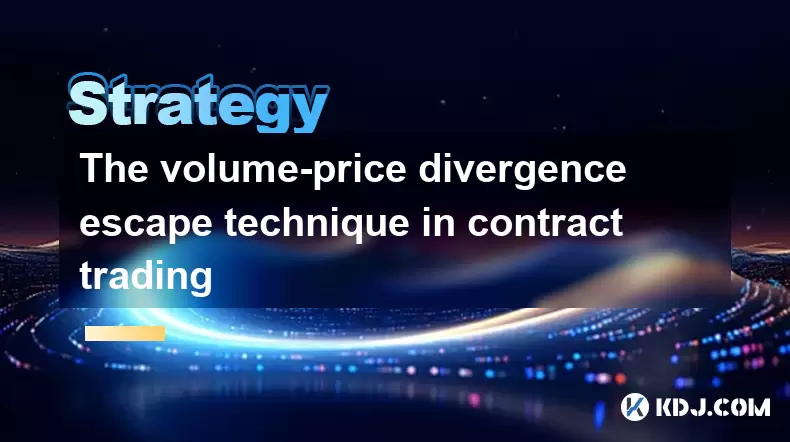-
 bitcoin
bitcoin $114320.977035 USD
-0.40% -
 ethereum
ethereum $4152.439985 USD
-1.75% -
 tether
tether $1.000111 USD
-0.04% -
 xrp
xrp $2.843037 USD
-1.63% -
 bnb
bnb $1013.349380 USD
-1.62% -
 solana
solana $208.362767 USD
-2.10% -
 usd-coin
usd-coin $0.999783 USD
0.00% -
 dogecoin
dogecoin $0.232559 USD
-1.00% -
 tron
tron $0.333491 USD
-1.09% -
 cardano
cardano $0.806310 USD
0.19% -
 hyperliquid
hyperliquid $45.023720 USD
-1.59% -
 ethena-usde
ethena-usde $1.000819 USD
-0.06% -
 chainlink
chainlink $21.241249 USD
-2.11% -
 avalanche
avalanche $30.035416 USD
-0.66% -
 stellar
stellar $0.364984 USD
-2.05%
The volume-price divergence escape technique in contract trading
Master the Volume-Price Divergence Escape Technique to identify potential escape points in crypto trading, enhancing your strategies with volume and price analysis.
Jun 12, 2025 at 01:21 am

In the dynamic world of cryptocurrency trading, mastering various techniques can significantly enhance your trading strategies. One such technique that has garnered attention among traders is the Volume-Price Divergence Escape Technique. This method leverages the relationship between trading volume and price movements to identify potential escape points in contract trading. In this article, we will delve deep into understanding this technique, its application in the crypto markets, and how you can implement it effectively.
Understanding Volume-Price Divergence
Volume-Price Divergence refers to a situation where the trading volume and price movements do not align as expected. Typically, a strong price movement should be accompanied by a corresponding increase in trading volume. However, when these two metrics diverge, it often signals a potential reversal or continuation of the current trend. Understanding this divergence can help traders anticipate significant price movements and make informed trading decisions.
To identify volume-price divergence, traders need to analyze both the price chart and the volume chart simultaneously. A common scenario is when the price continues to rise, but the trading volume starts to decline. This indicates that the upward momentum may be weakening, and a price correction could be imminent. Conversely, if the price is falling but the volume is increasing, it might suggest that the downward trend is gaining strength.
The Escape Technique in Contract Trading
The Escape Technique is a strategic approach to capitalize on the insights provided by volume-price divergence. In contract trading, particularly in the cryptocurrency markets, this technique can be used to identify entry and exit points that maximize profit potential while minimizing risk.
The escape technique involves monitoring the divergence closely and executing trades when certain conditions are met. For instance, if you observe a significant divergence where the price is moving up but the volume is decreasing, you might consider entering a short position, anticipating a potential price drop. Similarly, if the price is falling but the volume is increasing, it could be an opportunity to enter a long position, expecting a price recovery.
Implementing the Volume-Price Divergence Escape Technique
To effectively implement the volume-price divergence escape technique, traders need to follow a systematic approach. Here are the steps involved:
- Monitor Price and Volume Charts: Use trading platforms that allow you to view both price and volume charts side by side. This will help you spot divergences more easily.
- Identify Divergence: Look for instances where the price movement and volume do not align. A rising price with declining volume or a falling price with increasing volume are key indicators.
- Set Entry and Exit Points: Based on the divergence observed, set your entry and exit points. For example, if you see a bullish divergence, set a buy order at a specific price level, and set a stop-loss and take-profit order to manage your risk.
- Execute Trades: Once your entry conditions are met, execute your trades promptly. Monitor the market closely to ensure you exit at your predetermined levels.
Tools and Indicators for Volume-Price Divergence
Several tools and indicators can aid traders in identifying volume-price divergence more accurately. Some of the most commonly used include:
- Volume Oscillator: This indicator measures the difference between two moving averages of volume. It helps highlight significant changes in volume that may not be immediately apparent on a standard volume chart.
- On-Balance Volume (OBV): OBV is a cumulative indicator that adds volume on up days and subtracts volume on down days. It can help confirm price trends and identify potential divergences.
- Chaikin Money Flow (CMF): CMF combines price and volume to measure the buying and selling pressure for a specific period. It can be useful in spotting divergences between price and volume.
Case Studies: Volume-Price Divergence in Action
To illustrate the practical application of the volume-price divergence escape technique, let's look at a couple of case studies from the cryptocurrency markets.
Case Study 1: Bitcoin (BTC)In early 2021, Bitcoin experienced a significant price surge, reaching new all-time highs. However, astute traders noticed that while the price was climbing, the trading volume was starting to decline. This divergence suggested that the bullish momentum might be waning. Traders who recognized this divergence and entered short positions at the right time could have profited from the subsequent price correction.
Case Study 2: Ethereum (ETH)In mid-2021, Ethereum saw a sharp decline in price. However, the volume during this period was increasing, indicating strong selling pressure. Traders who identified this bearish divergence and entered long positions at the bottom could have benefited from the eventual price recovery.
Risk Management in Volume-Price Divergence Trading
While the volume-price divergence escape technique can be highly effective, it is crucial to manage risks appropriately. Here are some risk management strategies to consider:
- Use Stop-Loss Orders: Always set stop-loss orders to limit potential losses. Determine your stop-loss levels based on your risk tolerance and the volatility of the cryptocurrency you are trading.
- Position Sizing: Manage your position sizes carefully. Avoid over-leveraging, as it can amplify both gains and losses. A general rule of thumb is to risk only a small percentage of your trading capital on any single trade.
- Diversify: Do not put all your capital into one trade or one cryptocurrency. Diversify your portfolio to spread the risk and increase your chances of overall profitability.
Psychological Aspects of Trading with Volume-Price Divergence
Trading based on volume-price divergence requires not only technical skills but also psychological resilience. Here are some psychological aspects to keep in mind:
- Patience: Waiting for the right divergence to occur can be challenging. It requires patience and discipline to stick to your trading plan.
- Emotional Control: Avoid making impulsive decisions based on fear or greed. Stick to your strategy and let the data guide your actions.
- Continuous Learning: The cryptocurrency market is constantly evolving. Stay updated with the latest trends, tools, and techniques to refine your trading skills.
Frequently Asked Questions
Q1: Can the volume-price divergence escape technique be used for all cryptocurrencies?A1: While the technique can be applied to most cryptocurrencies, it is more effective in those with higher liquidity and trading volume. Cryptocurrencies like Bitcoin and Ethereum, which have substantial trading activity, are better suited for this technique. For less liquid cryptocurrencies, the volume data may be less reliable, making it harder to identify meaningful divergences.
Q2: How often should I check for volume-price divergence?A2: The frequency of checking for volume-price divergence depends on your trading style. For day traders, checking every few hours or even more frequently can be beneficial. Swing traders and position traders might find it sufficient to check daily or weekly charts. The key is to find a balance that aligns with your trading strategy and time commitment.
Q3: Are there any specific time frames that work best for this technique?A3: The effectiveness of the volume-price divergence escape technique can vary across different time frames. Short-term traders might find more opportunities on hourly or 4-hour charts, while longer-term traders could focus on daily or weekly charts. Experiment with different time frames to see which one aligns best with your trading goals and risk tolerance.
Q4: Can this technique be combined with other trading strategies?A4: Yes, the volume-price divergence escape technique can be effectively combined with other trading strategies. For example, you might use technical indicators like moving averages or the Relative Strength Index (RSI) to confirm the signals provided by volume-price divergence. Additionally, fundamental analysis can provide context to the market conditions, helping you make more informed trading decisions.
Disclaimer:info@kdj.com
The information provided is not trading advice. kdj.com does not assume any responsibility for any investments made based on the information provided in this article. Cryptocurrencies are highly volatile and it is highly recommended that you invest with caution after thorough research!
If you believe that the content used on this website infringes your copyright, please contact us immediately (info@kdj.com) and we will delete it promptly.
- BlockDAG, DOGE, HYPE Sponsorship: Crypto Trends Shaping 2025
- 2025-10-01 00:25:13
- Deutsche Börse and Circle: A StableCoin Adoption Powerhouse in Europe
- 2025-10-01 00:25:13
- BlockDAG's Presale Buzz: Is It the Crypto to Watch in October 2025?
- 2025-10-01 00:30:13
- Bitcoin, Crypto, and IQ: When Genius Meets Digital Gold?
- 2025-10-01 00:30:13
- Stablecoins, American Innovation, and Wallet Tokens: The Next Frontier
- 2025-10-01 00:35:12
- NBU, Coins, and Crypto in Ukraine: A New Yorker's Take
- 2025-10-01 00:45:14
Related knowledge

Practical parameter settings for a Bitcoin multi-timeframe moving average system
Sep 18,2025 at 10:54pm
Optimizing Timeframe Combinations for Bitcoin Trading1. Selecting appropriate timeframes is crucial when building a multi-timeframe moving average sys...

How can I filter out false breakouts in Dogecoin high-frequency trading?
Sep 22,2025 at 01:00am
Understanding False Breakouts in Dogecoin Trading1. A false breakout occurs when Dogecoin's price appears to move beyond a defined support or resistan...

Techniques for identifying tops and bottoms in the Bitcoin on-chain NVT model
Sep 20,2025 at 07:54pm
Understanding the NVT Model in Bitcoin Analysis1. The Network Value to Transactions (NVT) ratio is often described as the 'P/E ratio' of the cryptocur...

What does the surge in open interest in Bitcoincoin futures mean?
Sep 20,2025 at 11:18pm
Understanding the Surge in Dogecoin Futures Open Interest1. A surge in open interest within Dogecoin futures indicates a growing number of active cont...

How can I use the Ethereum USDT premium to gauge market sentiment?
Sep 18,2025 at 11:55pm
Understanding the Ethereum USDT Premium1. The Ethereum USDT premium refers to the price difference between USDT (Tether) traded on Ethereum-based plat...

What should I do if Ethereum staking yields decline?
Sep 20,2025 at 06:18am
Understanding the Causes Behind Declining Ethereum Staking Yields1. The Ethereum network transitioned to a proof-of-stake consensus mechanism with the...

Practical parameter settings for a Bitcoin multi-timeframe moving average system
Sep 18,2025 at 10:54pm
Optimizing Timeframe Combinations for Bitcoin Trading1. Selecting appropriate timeframes is crucial when building a multi-timeframe moving average sys...

How can I filter out false breakouts in Dogecoin high-frequency trading?
Sep 22,2025 at 01:00am
Understanding False Breakouts in Dogecoin Trading1. A false breakout occurs when Dogecoin's price appears to move beyond a defined support or resistan...

Techniques for identifying tops and bottoms in the Bitcoin on-chain NVT model
Sep 20,2025 at 07:54pm
Understanding the NVT Model in Bitcoin Analysis1. The Network Value to Transactions (NVT) ratio is often described as the 'P/E ratio' of the cryptocur...

What does the surge in open interest in Bitcoincoin futures mean?
Sep 20,2025 at 11:18pm
Understanding the Surge in Dogecoin Futures Open Interest1. A surge in open interest within Dogecoin futures indicates a growing number of active cont...

How can I use the Ethereum USDT premium to gauge market sentiment?
Sep 18,2025 at 11:55pm
Understanding the Ethereum USDT Premium1. The Ethereum USDT premium refers to the price difference between USDT (Tether) traded on Ethereum-based plat...

What should I do if Ethereum staking yields decline?
Sep 20,2025 at 06:18am
Understanding the Causes Behind Declining Ethereum Staking Yields1. The Ethereum network transitioned to a proof-of-stake consensus mechanism with the...
See all articles










































































